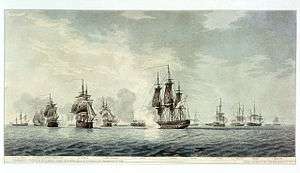French frigate Justice (1794)
Courageuse was a 40-gun Virginie-class frigate of the French Navy, completed in 1794 and renamed Justice in April 1795. The British and Ottomans captured her in 1801 at the siege of Alexandria and she became a prize to the Ottomans.
 Justice at the Battle of the Nile 1798 | |
| History | |
|---|---|
| Name: | Courageuse |
| Builder: | Jacques-Nöel Sané, Brest[1] |
| Laid down: | December 1793 |
| Launched: | August 1794 |
| In service: | December 1794 |
| Out of service: | 27 September 1801 |
| Renamed: | Justice |
| Captured: | 27 September 1801 |
| Fate: | Transferred to the Ottoman Navy after capture |
| General characteristics | |
| Class and type: | Virginie-class frigate |
| Displacement: | 1400 tonnes |
| Length: | 47.4 m (156 ft) |
| Beam: | 11.9 m (39 ft) |
| Draught: | 5.5 m (18 ft) |
| Armament: |
40 guns (though pierced for 44 guns) 28x18 pounder cannon and 12x12 pounder cannon |
| Armour: | Timber |
Career
Justice was named Courageuse on 5 October 1794 in error; there was already a Courageuse in service. She was renamed Justice on 20 April 1795.[1]
In late 1797 Justice captured the British privateers Cornish Hero and Fortune and took them into Corfu.[2]
She took part in the Expedition to Egypt. After the frigate Junon ran aground in Aboukir, Justice escorted her to Alexandria for repairs. She took part in the Battle of the Nile, managing to escape to Malta with the frigate Diane, and arrived at Valletta on 28 August 1798.
In 1800, she escaped to Toulon just before the fall of Malta. From there, she acted as a blockade runner for the benefit of the French army in Egypt.
Fate
She was in Alexandria when the British captured Alexandria on 2 September 1801. The British and their Ottoman allies agreed to a division of the spoils; the British received Egyptienne (50) and Régénérée (40), and the ex-Venetian frigate Léoben (26), and (ex-Venetian Medusa) (26), while Captain Pacha (sic) received Causse (ex-Venetian Vulcano) (64), Justice (46), Mantoue (ex-Venetian Cerere) (26), and the ex-Ottoman corvettes Halil Bey, Momgo Balerie, and Salâbetnümâ.[3] Admiral Lord Keith commander of the naval forces, gave the value of Justice for prize money purposes at £17,095 2s 2d.[4]
Citations
- Winfield & Roberts (2015), p. 149.
- Hardman (1909), p. 16.
- "No. 15426". The London Gazette. 10 November 1801. p. 1354.
- Lloyd (1950), pp. 358-9.
References
- Demerliac, Alain (1996). La Marine de Louis XVI: Nomenclature des Navires Français de 1774 à 1792 (in French). Éditions Ancre. ISBN 2-906381-23-3.
- Lloyd, Christopher (1950). The Keith Papers. 2.
- Hardman, William (1909). A History of Malta During the Period of the French and British Occupations, 1798-1815. Longmans, Green, and Company.
- Winfield, Rif; Roberts, Stephen S. (2015). French Warships in the Age of Sail 1786–1861: Design Construction, Careers and Fates. Seaforth Publishing. ISBN 978-1-84832-204-2.